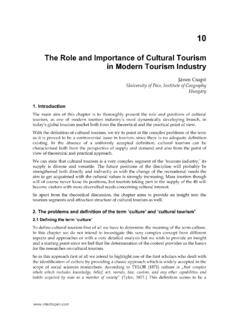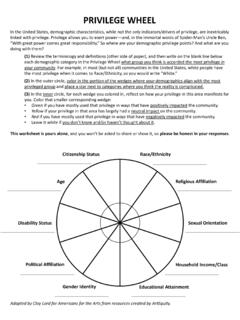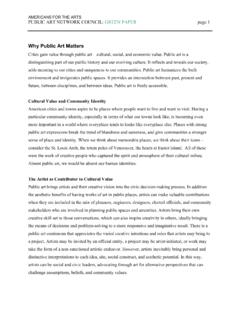Transcription of CULTURAL HERITAGE TOURISM - Americans for the Arts
1 CULTURAL . HERITAGE . TOURISM . ABOUT PARTNERS. FOR LIVABLE. COMMUNITIES. Partners for Livable Communities is a non-profit leadership organization working to improve the livability of communities by promoting quality of life, economic development, and social equity. Since its founding in 1977, Partners has helped communities set a common vision for the future, discover and use new resources for community and economic development, and build public/. private coalitions to further their goals. For more information visit 2 CULTURAL HERITAGE TOURISM Table of Contents INTRODUCTION. CULTURAL HERITAGE TOURISM | 5. 1. CULTURAL HERITAGE AS INTERPRETATION | 10. 2. PARTNERS' COMMUNITY BUILDING APPROACH TO. CULTURAL HERITAGE TOURISM | 14. 3. CULTURAL HERITAGE TOURISM ABROAD | 25. 4. HERITAGE TOURISM for All | 28. 5. How to Create a Local CULTURAL HERITAGE TOURISM Development Plan: Partners'.
2 Experience in Washington, DC | 34. 6. Model Experiences in CULTURAL HERITAGE TOURISM from Across the United States | 39. Endnotes | 62. Copyright 2014. Partners for Livable Communities 1429 21st Street, NW. Washington, DC 20036. Co-writers Robert McNulty Russell Koff Photo Credits Cover: Stuart Monk Inside Cover: Kim Seidl CULTURAL HERITAGE TOURISM 3. FORWARD. On our 35th year as an organization helping to empower communities with the tools to put them on the map as leaders in livability, Partners for Livable Communities is pleased to present this updated publication on CULTURAL HERITAGE TOURISM . As the TOURISM industry has boomed in the decades since Partners for Livable Communities began its CULTURAL HERITAGE TOURISM initiatives, communities have become increasingly eager to find ways attract tourists and capture the dollars they bring with them.
3 However, when hard times come, it can be a challenge to persuade those among us of the benefits of preserving culture , HERITAGE , and their artifacts from the past. This guide represents the culmination of our experience and TOURISM is too knowledge on an issue that has such a great potential for important a resource community development. More than three decades ago, some of the first initiatives in which Partners engaged focused on to be left to the TOURISM identifying and leveraging local CULTURAL assets as TOURISM professionals. TOURISM drivers. Our keystone program dating to the late 1970's called needs to be part of a culture Builds Communities, a collaborative effort with the national Endowment for the Arts, the national League of Cities, community mobilization the US Conference of Mayors and other groups, is an example strategy that can reinvent of such an initiative.
4 Partners continued to outline its approach the role of HERITAGE so to small-scale TOURISM development oriented around unique CULTURAL and natural assets in a 1990 article I wrote in the Journal that it serves the needs of of TOURISM Management. The article laid forth Partners' belief everyone. that small-scale TOURISM is often far more beneficial to local economies than the rapid expansion of massive resort enclaves Bob McNulty that dominate many TOURISM -dependent regions. President, Partners for Livable Communities With this publication, our hope is to demonstrate how CULTURAL HERITAGE is not just something to preserve for future generations, but is in fact an asset that can be leveraged to bring real economic benefits to the community. Sincerely, Bob McNulty Little Italy in New York City. Little Italy and Chinatown were listed in a single historic district on the national Register of Historic Places.
5 Photo credit: SeanPavonePhoto. 4 CULTURAL HERITAGE TOURISM INTRODUCTION TO. CULTURAL HERITAGE TOURISM . TOURISM A Big and Growing Business Before delving into CULTURAL HERITAGE TOURISM , one must first understand how TOURISM in general can act as a driver for community revitalization. TOURISM is a huge business both in the United States and the world over. In the US, tourists take more than a billion trips each year, and the tourist industry is one of the top three industries by number of jobs in 29 states. The US Travel Association estimates that in 2011 foreign and domestic tourists spent $813. billion on travel-related expenditures in the United States. According to the organization, this spending directly supported million jobs and generated $124 billion in tax revenue. Around the world, TOURISM is booming as well. The UN World TOURISM Organization announced the arrival of the one billionth tourist in 2012.
6 According to the organization, tourist arrivals have climbed remarkably from 674 million in 2000 to 980 million in The economic impact of this activity is likewise significant: TOURISM is directly responsible for five percent of the world's GDP, and the sector employs one out of every 12 people in advanced and emerging economies alike. TOURISM by the Numbers TOURISM is directly responsible Importantly, in the last several decades, along with its scale, the nature for 5% of the world's GDP. of TOURISM has also changed. As social and technological changes made The tourist sector employs 1 out TOURISM more affordable and accessible for millions of people, the of every 12 people around the once-traditional and long-awaited family summer vacation to the shore world, and 1 out of 8 in the US. became just one option among many that beckon all year round.
7 In the US, tourists spend more than $800 billion each year. of US GDP can be In the first version of this guide, Partners summed up the ongoing attributed to travel and TOURISM . changes in TOURISM by noting that TOURISM wasn't simply TOURISM Travel is among the top 10 anymore. It had become: a form of developmental, leisure, and industries in 48 states and the family bonding that occurs around the framework of visiting places District of that are not in your normal neighborhood. [I]t is lifestyle, economic development, and family values. It is a discovery of self, both physically and intellectually.. This shift in TOURISM from relaxation to self-discovery is reflected in the explosion of niche market designations within the TOURISM industry. The more widely known include adventure TOURISM , culinary TOURISM , religious TOURISM , ecotourism, sustainable TOURISM , and educational TOURISM .
8 CULTURAL HERITAGE TOURISM is one of the fastest growing specialty markets in the industry today. CULTURAL HERITAGE TOURISM 5. CULTURAL HERITAGE TOURISM As the term implies, CULTURAL HERITAGE TOURISM involves visiting places that are significant to the past or present CULTURAL identity of a particular group of people. In the United States, America's rich history has created a vibrant and complex patchwork of CULTURAL heritages. Americans are accustomed to an array of compound identities African Americans , Asian Americans , Hispanic Americans , Irish Americans , Italian Americans , Native Americans that jointly indicate the communities from which they come and the nation they now share. While this lively history has long been honored in festivals and parades, CULTURAL HERITAGE goes deeper than merely an occasion for celebration. CULTURAL HERITAGE encompasses what a particular group of people has in common that makes them different from others.
9 At a broad level, there is an American culture that helps to define all Americans , but there are also a host of different traditions that shape a range of more distinct CULTURAL backgrounds. For newer immigrants, this HERITAGE is rooted in the language, customs and practices brought over from their respective countries of origin. But for Americans whose families have been here for generations, CULTURAL HERITAGE comes CULTURAL HERITAGE TOURISM Destinations from the history and experiences these groups have shared over the years. Museum of Latin American Art, Long Beach, CA. The Capitol Arts Center Theater, Bowling Green, KY While music, movies and other media help tell some Washington State's HERITAGE Tours of the stories about different cultures and heritages, Museum of African American history , Boston, MA there is still much to be learned about the experiences Italian HERITAGE Parade, San Francisco, CA.
10 Of the many communities that make up the United chaco culture national historical park , New Mexico Savannah Historic District, Savannah, GA States. The Kurt Vonnegut Memorial Library Indianapolis, Indiana CULTURAL HERITAGE TOURISM provides an opportunity for Smithtown historical Society, Long Island, NY people to experience their culture in depth, whether Scandinavian Festival, Junction City, OR by visiting attractions, historical or culturally relevant District of Columbia places, or by taking part in CULTURAL activities. As it is strictly defined by the national Association of State Arts Agencies, CULTURAL HERITAGE TOURISM is based on the mosaic of places, traditions, art forms, celebrations and experiences that portray this nation and its people, reflecting the diversity and character of the United States. 3. Put another way, the national Trust for Historic Preservation defines CULTURAL HERITAGE TOURISM as travel to experience the places, artifacts and activities that authentically represent the stories and people of the past and present, including CULTURAL historic and natural resources.



